Try Dragonboat
Free for 14 Days
Get started in minutes-no credit card required

A/B testing or split testing is a way to compare two versions of a variable to determine which performs better, using a pre-determined metric. For example, you could test a red sign-up button vs a blue one to see which has a higher click-through rate.
A/B testing requires creating two separate environments and testing the alternatives with randomized sets of users. By randomizing which users are in each group, you minimize the chances that other factors, like region or device, will drive your results on average.
A/B Testing can be conducted in a five-stage process:
1. Choose your metrics
2. Create your hypothesis
3. Create your test environment
4. Run your test
5. Compare your results
In software product development, Agile is a way of managing development work that is characterized by the division of tasks into short phases, aka sprints, and frequent reassessment and adjustment of plans. Unlike the Waterfall methodology, where the project scope is fixed and the budget and timeframe may change, Agile sets a limited timeframe and budget with an estimated scope.
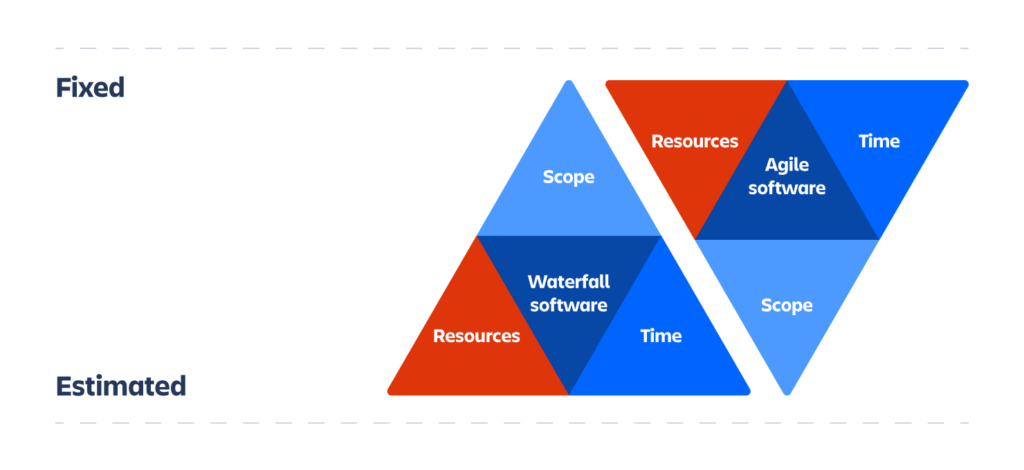
Source: Atlassian
Agile emphasizes taking an iterative approach to product development where the primary focus is on delivering first a minimum viable product, reducing the stress and risk involved with major product launches. By working in small increments, Agile teams are more able to respond to changes in the business goals and shifting market demand.
Successful product-centric organizations that work in an Agile environment also implement Responsive Product Portfolio Management (Responsive PPM) to maintain their agility at any size and scale.
Learn more about why Responsive PPM matters to Agile organizations.
In order to remain competitive in today’s market, technology companies must be able to form teams, build backlogs and regularly deliver product increments to customers. Agile Transformation is the work of refactoring an organization so that it can fully adopt the Agile methodology and, most importantly, internalize its guiding principles.
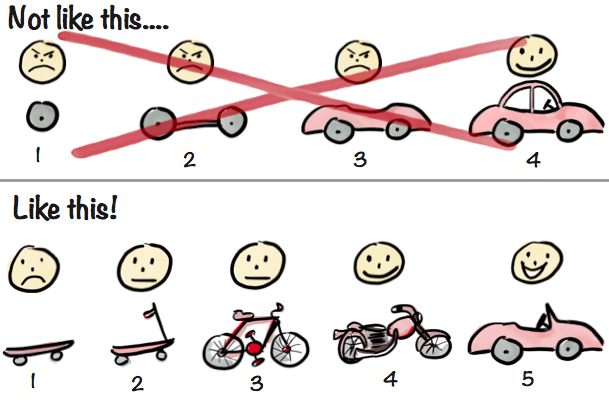
Source: Henrik Kniberg
An agile environment is responsive, embraces creativity and innovation, empowers teams and reduces process bloat. This transition is not limited to a product development team — for it to truly stick, it must occur at all levels and across all teams.
For small companies, Agile Transformation can be straightforward and for new ones, Agile may already be standard. However, for large, complex organizations with legacy products, transformation must be carefully managed with the help of an Agile Transformation management platform to ensure that the associated work and investment will result in true Agility.
Alpha tests are the initial end-to-end test used in product testing to determine if the product is working as it is intended. The purpose of alpha testing is to find any bugs or issues before the product is launched. Alpha tests are typically done in a controlled staging environment by the company’s internal employees. Alpha testing is usually followed by beta testing, where a subset of users is invited to test the product before its official release.
Annual planning is the yearly practice of setting overall company strategy to drive long-term and short-term goals and expectations. Its purpose is to give the organization a direction and a clear guide on how to reach these milestones. The output of strategic planning enables the strategic context from leaders to their teams. Read our Step-By-Step Guide to Annual Strategic Planning.
Strategic Planning consists of four steps:
In Responsive Product Portfolio Management, product outcomes influence future company decisions. Therefore, continuous planning takes place on a monthly and quarterly basis.
A product backlog refers to ideas, epics, or initiatives that support a project or goal but are put on hold to work on in the future. The backlog could serve as the source of truth for upcoming sprints or as a repository of ideas. Regardless, it is always important to keep your product backlog well-groomed and prioritized in a tool.
Learn more about product prioritization frameworks to manage your backlog.
Beta testing is the point in product testing when a private group of real consumers can test the product or service in a controlled setting. The purpose is to find any functional non-conformities or major UX/IU issues before the product is launched. Beta testing is typically done in a production environment by real users and is preceded by alpha testing.
Bottom-up innovation occurs when employees generate ideas and identify new opportunities, bubbling them up to the top. Employees lead the idea through the innovation process by using their insights, experience, and influence in their network rather than navigating company hierarchies.
Elite product organizations are designed to inspire bottom-up innovation because often, the Product Managers, Customer Success Managers, and their “front line” colleagues identify the biggest opportunities. However, for bottom-up innovation to be truly advantageous, it must be coupled with top-down alignment on company goals and vision in order to ensure that new ideas actually help move the company in the right direction.
“The build trap is this place where organizations get stuck and focused on how much are they are shipping and not what those features actually produce. What is the value for the customers and the business that we’re actually driving?… Did it result in more revenue? Do we have happier customers? Are people staying with us more? We’re not tying back the things that we’re actually doing at the team level to what the organization wants to achieve.”
Learn more about how to escape the build trap and become outcome-focused.

Melissa Perri, CEO, ProduxLabs
Buyer personas are fictional characters who represent the ideal profile of a potential buyer, guiding product, development, and marketing teams with insights about the people who decide to purchase your product or service. Buyer personas are a useful tool to inform your go-to-market strategy and product development process.
A change agent oversees the change management process. Change management is necessary when a new process or workflow is being rolled out and needs to be adopted by various teams. A change agent can be a dedicated resource focused on driving that project or it can be a component of someone’s job. Whether it be Agile transformation or scaling product management to product portfolio management, a change agent champions the movement.
Within the product organization, the roles that usually act as the change agent are the Chief Product Officer, Product Operations or Agile Coach or Consultant.
A change agent’s goal is to facilitate effective transformation without disrupting the organization. Their responsibilities can include creating a change management plan and roadmap, leading a change management team, and communicating change to the organization.
Change management is the structured process of supporting an organization through a people, process or technology change. Significant organizational change can be challenging. It often requires many levels of horizontal and vertical collaboration and across teams. Developing a structured approach to change is critical to help ensure a beneficial transition while mitigating disruption.
Change management typically consists of a change agent to drive visibility around the change, communicate the plan, and drive progress towards it while minimizing disruption.
The Chief Product Officer is a C-suite leader and the highest level executive within a company’s product organization. The CPO leads product teams across multiple product lines and divisions while setting the strategic product direction. Chief Product Officers oversee product vision, innovation, design, development, and the entire product portfolio.
While Product Managers often have a mindset based on prioritization, CPOs shift their mindset towards allocation, financial resources, and business objectives to move the whole company forward, not just one product. Successful Chief Product Officers ensure product investment is aligned to business goals and accelerate outcomes while reducing operating costs.
Modern CPOs apply a portfolio approach to balance the needs of customers, business goals (OKRs) and scarce engineering resources to achieve the best product outcome.
“A CPO is at the executive level and needs to understand the gaps, design the strategy and enable themselves with enough data to get answers and drive results. It’s such an important role for any organization that uses software as you can make or break the business strategy.”
– Melissa Perri, CEO, ProduxLabs
Check out these great resources for CPOs:
Churn refers to the number or percent of users that cancel or discontinue their subscription. A high churn rate is indicative of general dissatisfaction with a product or service.
Churn rate = (Customers lost in a period / customers at the start of a period).
In Responsive Product Portfolio Management, continuous planning is the natural evolution of annual planning where outcome-focused teams continuously review and re-analyze strategy and use past product outcomes to influence future company decisions. Agile companies take a continuous planning approach to ensure they remain competitive and responsive to changing market needs, product performance and new inputs.
Cross-team collaboration occurs in a product organization when a group of people with a wide range of skills from different product areas and/or multiple teams (like engineering, marketing, and customer success) work together in order to complete a project or contribute to a shared initiative. Cross-team collaboration is often essential in order for large, multi-quarter initiatives to be successful.
Within the product organization, product operations plays a key role in orchestrating cross-team collaboration because they increase stakeholder visibility, plan outcomes and facilitate quarterly planning.
A customer-centric company (vs product-centric) focuses on keeping its customers happy above all else. The end goal is to create a product that completely satisfies its users. Therefore, the company will pour all of its resources into this aim. The value of a customer-centric company is that customer needs will be a top priority, but needs pertaining to protecting the company’s longevity may go unmet. A potential risk of a customer-centric approach is becoming a feature factory.
Daily scrums refer to a practice in Agile where team members meet daily to briefly report their progress. The goal of daily scrums is to create team alignment and visibility on work and to drive progress towards the sprint goal while identifying any blockers or dependencies.
Modern Agile teams use a portfolio management tool to greatly minimize the time spent in daily scrums.
A major aspect of product portfolio management is identifying dependencies. A dependency may occur when one epic or feature is related to another in a logical timeline sequence: Feature B cannot be released without first releasing Feature A. There are four common types: feature, technical, resource, and external-related dependencies.
Dependency management at the portfolio level usually falls under the responsibility of Product Ops or a Product Portfolio Manager and involves:
DevOps, short for Development Operations, is the combination of software development and IT operations. The purpose of merging the two functions is to coordinate the processes so that the product lifecycle is accelerated, more reliable, and more efficient. The idea behind DevOps is collaboration and teamwork.
The DevOps lifecycle refers to the continuous, collaborative work cycle of DevOps. It typically consists of six continuous phases that utilize tools and processes to ensure success.
The DevOps Lifecycle phases include:
Development
Integration
Testing
Monitoring
Feedback
Deployment
Operations
Digital transformation is when organizations radically revamp their strategy, process, and execution to incorporate digital technologies. The purpose is to adapt to the more competitive, modern market so that the business may be more efficient, scalable, and ultimately, future-proof.
Digital transformations have great benefits but can be disruptive which is why a great change management strategy is vital.
In Responsive Product Portfolio Management, Double Diamond Strategy and Execution refers to the two distinct and interconnected phases at each organizational level: the strategic cycle and the execution cycle. These cycles correspond to the discovery and delivery cycles in building products.
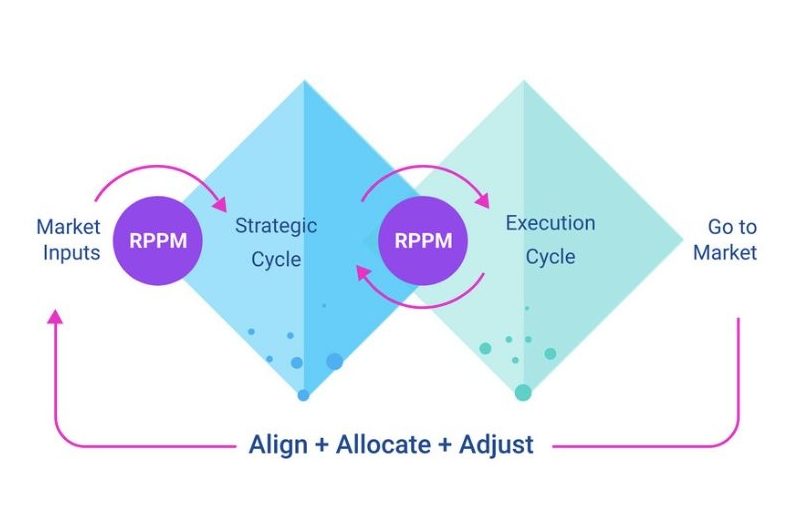
Each cycle focuses on a different time horizon at the same operating level. For example, at the executive level, there is an annual strategic horizon, and a quarterly execution focus.
The strategic cycle focuses on aligning goals, defining strategies, evaluating opportunities, and assessing resource allocation. The outputs of the strategic cycle provide the guidepost for the execution cycle to iteratively deliver, measure, and adjust.
End-user refers to the person who will actually use or is meant to use a product. This is a common term in the B2B software industry where, typically, the decision to purchase a product is made at the executive level. However, ultimately, it is the employees who will make up the majority of a product’s end-users. When creating buyer personas, it is important to include end-user profiles.
An Epic (aka project, EPIC in Jira/Shortcut, a milestone in Github, or a feature in Azure DevOps) typically lasts a few weeks/ sprints and is built by one team. Epics are mapped to initiatives which typically last a few months to quarters. An initative could have multiple epics that may be built by several teams. Product teams typically break epics down into user stories before they start designing and building functionality.
In Dragonboat, an epic represents the lowest level in the product portfolio hierarchy.
Regarding a physical or digital product, a feature describes a customer benefit and the desired outcome. An individual feature may impact a product’s user interface, functionality, capabilities, security, and speed.
The term, “feature factory” holds a negative connotation and describes an organization that is overly focused on churning out incremental product improvements and features instead of creating new and more impactful solutions for customers.
Feature factories have a tendency towards:
The opposite of a feature factory is an outcome-focused product organization.
Gantt charts are commonly used in project management. They are a visualization showing activities (i.e. Epics, tasks, or projects) displayed against time. The top shows the time scale such as week, month, or quarter. The left side displays the activities. The Gantt chart was created by Henry Gantt, a mechanical engineer and management consultant who is best known for his work in the development of scientific management. He created the Gantt chart in the 1910s.
In Dragonboat, Gantt charts are one of the format options in which you can view your roadmap or portfolio to make tracking progress and roll-up easier in real-time.
A goal is a measurable, time-bound objective that includes a key performance metric, which you will use to measure your success. Goals should be specific, measurable, achievable, relevant, and time-bound (SMART).
A go-to-market (GTM) strategy is a step-by-step guide that details how a company will reach target customers and achieve a competitive advantage. The purpose of a GTM strategy is to provide an actionable plan for successfully launching a product in the market. A GTM plan identifies a target audience, includes marketing plans, and provides a blueprint for a sales and distribution strategy.
Hardware refers to the tangible tools or mechanical equipment involved in developing or using your product. An example is the physical components of a computer and the elements needed to use it such as a keyboard and mouse.
Product teams use the Hierarchy of Needs as an aspirational theory to pursue the ultimate goal of delivering outcomes. From the bottom of the hierarchy upwards, the needs are:
Every member of the product delivery team wants to move up the hierarchy towards being outcome-focused. Needs lower in the hierarchy must be satisfied before the product team can attend to higher needs. Failure to meet higher-level needs is often disrupted by a failure to meet lower-level needs. Market conditions, customer expectations, and leadership changes are a few reasons that cause teams to fluctuate.
Therefore, not every individual or functional team will move through the hierarchy in uniform but may move back and forth between the types of needs.
Becky Flint (Founder of Dragonboat) details how teams progress from the essentials of roadmapping up to becoming experts at delivering outcomes in her blog post titled: The Hierarchy of Needs for Outcome-Focused Product Teams.
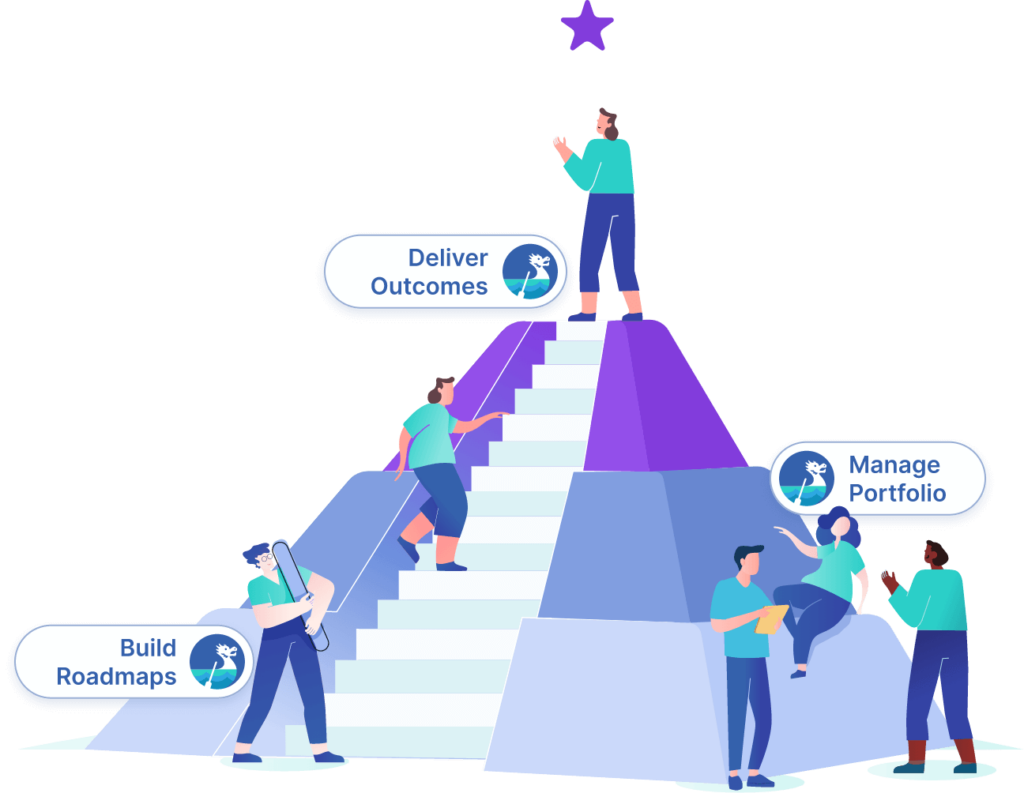
In the product world, initiatives are a combination of key ideas and features that make up multi-month or quarter-long projects designed to achieve company objectives. Initiatives involve bringing together technical improvements, new features, and other activities into themes that structure the product workflow.
In the Responsive PPM framework, initiative sits at the middle level of an organization’s strategy and execution horizon. Initiatives should be connected to OKRs and roadmaps for outcome-driven product management.
In Dragonboat, the term is used for large undertakings that may have multiple ideas associated with them. You can think of initiatives as large ideas, programs, or in SAFe, EPICs. Initiatives are a great way to group your ideas in Dragonboat.
A stage in the product development life cycle (PDLC) the Intake Process refers to the gathering of customer requests and insights as input for the development of new features and product improvements. A good process and the right product portfolio tool are necessary in order to make sure that all requests are organized, prioritized, and cataloged so that they can be evaluated across multiple dimensions (business goal, customer, platform, timeframe, etc).
Jobs-To-Be-Done (JTBD) is a framework based on the belief that people “hire” products and services to get “jobs” done, i.e., to help them accomplish tasks, achieve goals and objectives, resolve and avoid problems, and to make progress in their lives.
While conventional marketing focuses on market demographics or product attributes, JTBD goes beyond these categories to discover the functional, social, and emotional dimensions that explain why customers make certain choices.
As a result, you can make improvements to your products that will get the job done better. This is the key to mitigating investment risk and forecasting revenue accurately. Clayton Christensen, an American academic and business consultant, popularized the framework.
Kanban is an approach to project management and agile software development attributed to David J. Anderson, inspired by the theory of constraints and the Toyota Product System. Kanban is a popular approach for product teams to design, manage, and improve flow systems for product development work. Many tools used by modern software companies like Trello and Jira incorporate Kanban today.
The board view (resembling a kanban board) in Dragonboat follows the kanban framework with its real-time visualizations of capacity and transparency.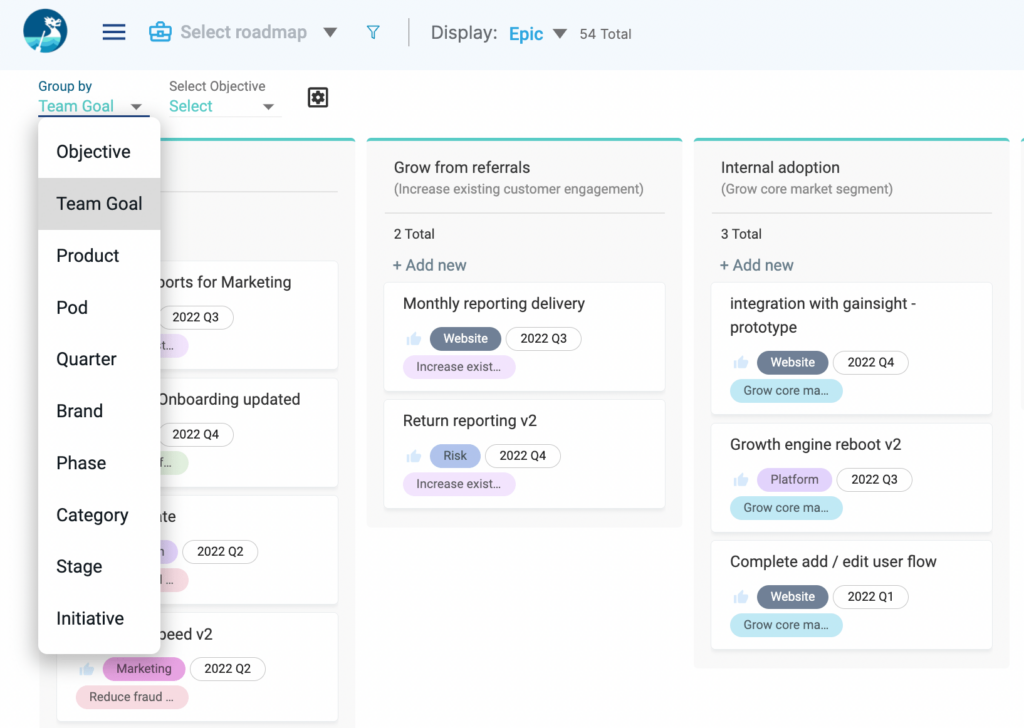
Kano is a product prioritization framework that focuses on the features that maximize customer satisfaction against their associated costs. Its principles lie in the idea that “less is more” and that over time, features can change from being seen as “nice-to-have” to “given” as customer expectation levels rise.
Lean product development is a method for developing products that focuses on reducing waste, speeding up delivery, and increasing profit and customer value. The Lean approach is different from agile product development because lean focuses on making the most efficient use of resources and processes, while agile focuses on the quickest way to get things done.
One commonly cited example of Lean Product Development comes from Toyota. In 2000, it used lean product development to launch 14 new products. This was more than GM’s entire product offering, with only 70,000 employees compared to GM’s 350,000.
Metrics Over Available Resources (MoAR) is the ratio of contribution of a product feature towards the desired business outcome (the metric) over the number of available resources needed to achieve this contribution. For example, the metric could be a leading indicator of future monetary returns such as user growth, referral rate, retention, and NPS.
MoAR is the preferred product prioritization framework in Responsive Product Portfolio Management because it ties to the company goals and strategies, accounts for immediate resourcing needs, and allows product leaders to plan based on dynamic metrics.
Many companies are switching from ROI to MoAR because it is a more immediate measure to evaluate opportunities that maximize product and business outcomes. See Forget ROI, Use MoAR for Product Portfolio Metrics.
The MoSCoW model is a prioritization method that ranks the importance of different product requirements. The acronym represents the scoring, which can be broken down into four categories: “Must-Have”, “Should-Have”, “Could-Have” and “Wont-Have” or “Wish”.
Read how to apply MoSCoW and other product prioritization frameworks.
Responsive Product Portfolio Management (Responsive PPM) emphasizes that even a single product can be managed as a portfolio because it needs to be assessed across various dimensions. Some examples of the different product dimensions are:
The benefits of managing your product as a portfolio across multiple dimensions include:
Learn more about how to manage your product portfolio – even with only one product.
Created In 2003 by Fred Reichheld, a Bain & Company partner, Net Promoter Score (NPS) is a way of measuring how well an organization generates relationships worthy of loyalty from its customers. The input for the score comes from asking customers how likely they are to recommend your product or service to others on a scale of 0-10. Aggregate NPS scores help product-centric organizations improve upon customer success, support, onboarding, delivery, etc. for increased customer loyalty.
OKR is an acronym for “Objectives and Key Results,” a goal management framework pioneered by John Doerr to help companies implement and execute strategies to move from focusing on outputs to outcomes.
An OKR consists of:
Companies are often on the lookout for ways to enhance their performance. OKRs are a great solution as they help align employees’ own objectives to the company goals and ensure that the efforts they are putting in are driving results.
One-product portfolio is an idea that comes from Responsive Product Portfolio Management. It refers to a digital product that can be managed as a portfolio because it consists of a bundle of product areas that serve different use-cases and markets. This perspective is based on the idea that every product manager supports multi-dimensional portfolios with multiple customer segments, investment categories, and business outcomes.
One example of a one-product portfolio is Google Search. Each Product Manager within the Google Search product team is responsible for building a facet of the search engine (e.g. Core Algorithm, Suggestions, Ads, etc.) within the company’s overall product portfolio.
Outcome-driven product management or outcome-focused product management is an approach for product-centric companies to bring to market and oversee a product or portfolio of products in a way that emphasizes outcomes over outputs. Top-down alignment, bottom-up innovation, and cross-team collaboration are all essential ingredients for an effective outcome-driven product organization.
The baseline for outcome-driven organizations begins with setting clear goals from which teams can brainstorm the best solutions to achieve them. Teams tie their strategy to goals and measure their progress towards the desired outcomes.
Here are three signs of a healthy, outcome-driven product organization:
Learn how to make the switch from feature-based to outcome-driven product management.
An outcome roadmap or, similarly, anOKR roadmap is a product roadmap that is designed in a way that communicates not only the what and the when of what to build, but also the “why” for greater clarity and communication across the product org and stakeholders. Read our Step-by-Step Guide for OKR Roadmapping.
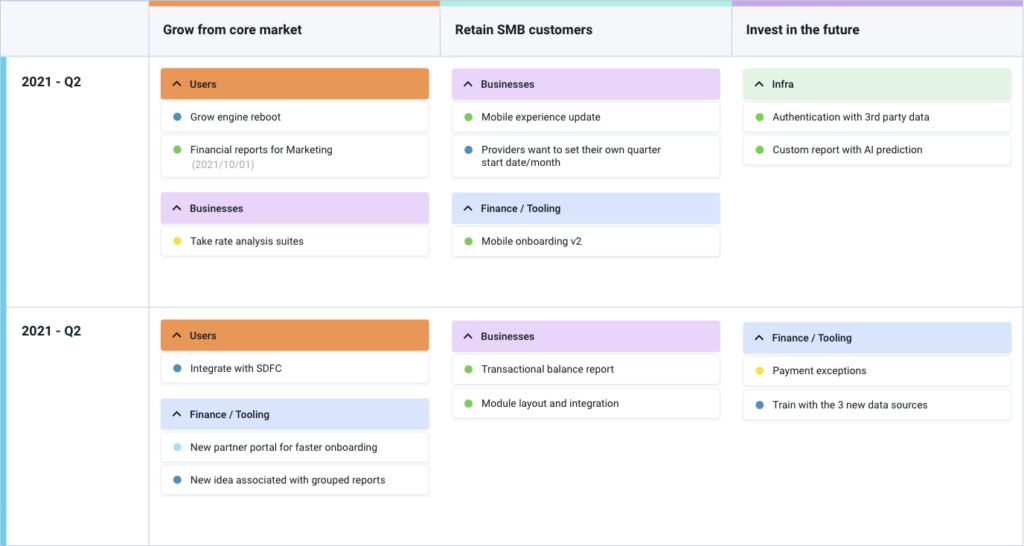
With requests, feedback, and insights coming from multiple stakeholders and data sets, product teams can easily find themselves stuck in the “build trap”- building features without having visibility into their impact on the company goals.
Outcome roadmaps are a response to the pitfalls of traditional, feature-based roadmaps which are built upon a backlog of ideas to improve the product based not only on customer feedback, but also market trends, team insights and product results. The problem with the feature-based roadmapping model is that the prioritization method is linear. With the multitude of factors and dimensions that actually come into play during decision-making, such as business, customer, and market needs and timelines, an approach with more depth and perspective is required.
Outcome-focused product teams start outcome roadmapping by defining their desired goals and outcomes and then deciding which actions are needed to achieve them. A purpose-built tool like Dragonboat allows you to consider all the dimensions of your business, customer, and portfolio, as well as time horizons to ensure success in both the near and long term.
PDLC stands for “Product Development Life Cycle” and it describes the end-to-end process of taking a product from idea to market release to continuous improvement. The PDLC will look different in every organization but can typically be broken down into these stages: idea intake, alignment, strategic prioritization, agile development, and go-to-market.
At an outcome-driven organization, the PDLC process will connect strategy and execution and be flexible to adjustments.
A product analyst works under the umbrella of product operations.
“This person is concerned with how the team is getting its data, the tools it uses, and most importantly, how the team can connect all the dots. Many teams are great at collecting and presenting data, but fall short when it’s time to identify potential trends or insights that could be useful for making better decisions. A product analyst will develop consistent reporting to inform a product team’s strategy.”
Learn more about the two types of product operations roles.

Denise Tilles, CPO, Grocket
Product-centric refers to an organization that revolves around the development of products, independent of the current market demand. Product-centric companies find customers that fit their product rather than the other way around. They are more concerned with adding value to the industry and creating a new product that solves problems on a deeper level than releasing an improved version of existing solutions.
The value of a product-centric company is that if you have identified a problem to solve with your product, then it will serve an unmet customer need. At the other end of the spectrum is customer-centric.
Product-led growth (PLG) is a business model focused on end-users where the product itself is what primarily drives user acquisition, expansion, conversion, and ultimately, retention. It is mainly indicative of how software is used and bought in the modern digital age. With this strategy, a company will often offer a free trial, freemium, or include viral features that encourage growth and lead a portion of free users to upgrade to a paid plan.
Some famous examples of companies with a PLG strategy include Slack, Calendly, and Dropbox. Any company, even those selling in the enterprise market, can adopt PLG principles to improve customer delight and increase go-to-market efficiency.
Product management is the business process of planning, developing, launching, and managing a product or service. It includes the entire lifecycle of a product, from ideation to development to go to market. Wikipedia
We want to hear from you! What’s your definition? Submit it here.
A product mission statement is a concise representation of the purpose and the expected outcome of the product. The product mission statement should define for whom the product is made and how it positively benefits its users.
In one easy-to-understand sentence, the product mission should set the product team’s goal and convey the product’s value to the users. At the same time, it should focus on the intended users of the product. It should inspire the team to achieve its targets efficiently and let the prospective users know why they should have said product.
Product Operations or Product Ops is a fast-growing role in modern software organizations. The purpose is to enable an effective, outcome-focused product organization, and broadly speaking, a product-led company, to achieve the best portfolio outcomes.
Product ops typically serves as the right hand to the Chief Product Officer, and the benefits of product ops can be felt company-wide:
Though the job title of product operations is relatively new, the role and needs have been around for a long time. Product operations responsibilities have previously been owned by Portfolio Managers, Program Managers, or Chief of Staff to the CPO.
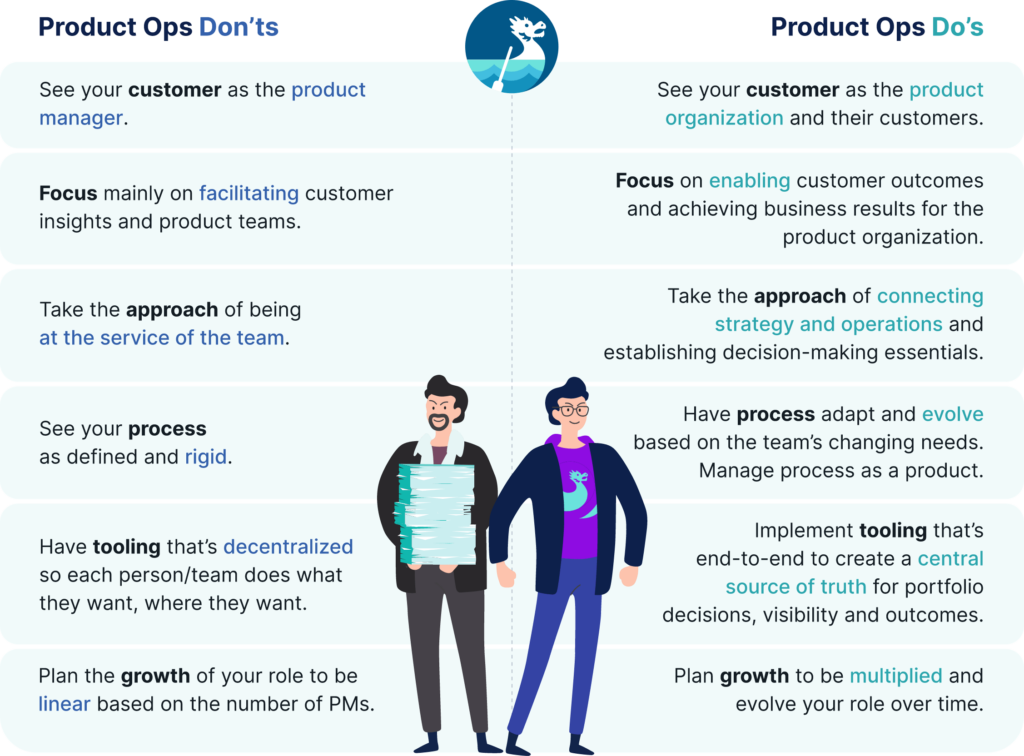
Learn more about the role of product operations and its responsibilities.
A product operating model is the underlying infrastructure for how a Chief Product Officer drives the success of a product organization and, in turn, their company.
A product portfolio not only describes a collection of multiple products but can also be used to describe a multi-dimensional product or a one-product portfolio. Roadmaps can be viewed as individual snapshots of the portfolio, highlighting information from various dimensions (timeframe, goal, team, segment, etc.)
It is important to implement the responsive product portfolio management framework to maximize portfolio outcomes and implement a platform to enable alignment and visibility such as Dragonboat.
A product portfolio not only describes a collection of multiple products but can also be used to describe a multi-dimensional product or a one-product portfolio. Roadmaps can be viewed as individual snapshots of the portfolio, highlighting information from various dimensions (timeframe, goal, team, segment, etc.)
It is important to implement the responsive product portfolio management framework to maximize portfolio outcomes and implement a platform to enable alignment and visibility such as Dragonboat.
As a product organization grows, so do the growing pains like chaos, misalignment, dependencies, and resource bottlenecks. Outcome-focused product organizations adopt product portfolio management, the craft of managing complexity and delivering the best product outcomes, given constraints.
A continuous and dynamic process, product portfolio management can be applied to manage a multi-dimensional product or an entire product portfolio that includes all of the products a company has on the market and under development.
Product portfolio management is rooted in the same principles as portfolio management in the financial industry. Similar to financial advisors, product executives must focus on picking the right investments that will lead to the greatest yield, or product portfolio outcomes. These investments don’t necessarily need to be across different products. They can also be across different choices. For instance, the allocation between regions (US vs. APAC), goals (customer acquisition vs. retention) or timeframes (now vs. long-term).
Modern, product-centric companies take the Responsive Product Portfolio Management approach to dynamically connect objectives, customer needs, products, and resources with execution to accelerate outcomes while staying responsive to the state of the organization and the market.
Interested in learning more? Check out our article, “What is Product Portfolio Management? The Secret Propelling Product Leaders Forward.”
A product portfolio management tool is the operating system and source of truth for product teams. Much like engineering teams need Jira, sales teams need Salesforce and support teams need Zendesk, product teams need a tool like Dragonboat.
Dragonboat is the leading product portfolio tool for outcome-oriented teams to strategize, prioritize, deliver and improve industry-leading products. With Dragonboat, product teams can connect goals with initiatives, build data-driven roadmaps, integrate with engineering tools like Jira and Shortcut for execution, and inform future iterations with past results all in one place.
With Dragonboat, CPOs and their teams can ensure product investment is aligned to business goals and accelerate outcomes while reducing operating costs.
The process of launching a newly-built digital product for a particular market or a predefined user base is known as Product Release.
Program management is the coordination and orchestration of a collection of products and product features that are building toward a common outcome. The practice of program management takes a more lateral approach to product management where the focus lies on mapping and sequencing the dependencies across products, product features, standalone projects, and even operational activities when needed. This lateral approach will take a more cross-cutting perspective on the risks, resourcing, schedules and value generated from the pursuit of these outcomes. This results in programs being in direct service to more organizational initiatives and outcomes, though some organizations may use these terms synonymously.

Tom Briones, Program Director, Rangle.io
Quarterly planning, aka quarterly alignment, is an integral activity for a responsive product organization to connect OKRs with execution. When done correctly, it helps reduce development waste and ensures that teams are “rowing” together in the right direction.
Quarterly planning involves product leaders and their teams aligning on the next phase of focus (ie increase retention or launch to new markets) within product functions and their engineering, business, and other key stakeholders.
Read our Step-by-Step Guide to Quarterly Planning for Product Teams.
The process of managing new product feature requests from customer feedback and other stakeholders is known as request management. Product managers must collect, organize, and prioritize feedback, requests, and insights before tying them to new or existing product features or initiatives.
Portfolio resource planning and allocation enables companies to maximize portfolio outcomes with the resources they currently have or could acquire. Planning and allocating resources is important in order to do forecasting. Your product plan and strategy is only as good as your teams ability to deliver on it.
Understanding resourcing limitations and constraints helps outcome-focused product teams ensure that they’re best prioritizing features, making sound trade-off decisions, and allocating and re-allocating their resources to the areas that will have the highest impact.
“When drawing the line with allocating resources, it comes down to Dragonboat to provide that clarity because you need to explain why you are drawing that line and show all the other things going on. There are only a certain number of things you can deliver before you reach capacity. This opens the door to talk about what is possible and what is not. It’s about communicating what you can give in a meaningful way.”
– Alex Diallo, Chatmeter
Using Dragonboat, product executives and program managers can run robust “what-if” analyses in real-time in order to make roadmap trade-off decisions with a clear understanding of impacts. Additionally, they can see how their actual allocation compares to their planned allocation and overlay that information with performance results to make informed decisions if anything needs to be adjusted.
Responsive PPM has 5 Key Principles:
Check out the new home for Responsive Product Portfolio Management – the fastest-growing community for outcome-focused product teams.
The RICE prioritization model is a weighted prioritization model that was popularized by Intercom. RICE evaluates competing ideas by scoring them based on (Reach x Impact x Confidence)/Effort.
“Using a scoring system like RICE, you can understand the value of a feature or project against the effort to determine what to focus on. At Chatmeter, we use RICE scoring to understand if a product is valuable. But if it’s going to take 100% of our resources for three months, maybe it’s not the first thing to focus on this quarter”
– Alex Diallo, Chatmeter
See how to use RICE and other product prioritization frameworks.
Roadmapping is a component of product portfolio management and a great tool to provide a proposed plan and goals for a project to be updated and shared. Roadmapping tools are useful to collect and organize customer feedback/ insights, prioritize product features, visualize product plans and share insights with stakeholders.
Learn when to use a roadmapping vs a product portfolio management tool.
The Scaled Agile Framework (SAFe) is used by enterprise companies to implement agile delivery at scale. SAFe promotes alignment, collaboration, and delivery across large numbers of agile teams. It provides structured guidance on roles and responsibilities, as well as how to plan work.
Companies that practice SAFe typically lead a portfolio, or portfolio of portfolios, and need a responsive Product Portfolio Management platform to manage the integrated workflows.
The Say:Do ratio measures how well you deliver on what you say you are going to do. The higher a product leader’s Say:Do ratio, the more dependable they seem, the greater power they have to rally and align with stakeholders, and the greater trust they’ll earn from peers, supervisors, and direct reports. This ratio is especially important for product professionals moving up the career ladder because as your circle of influence grows, so too does your level of accountability.
The Shape Up Method is a framework used by product development teams to shape and build impactful products. It uses an iterative structure where small teams complete projects in six week cycles. Each cycle is followed by a two week period where teams take on unscheduled work as required. The method was introduced in the book “Shape Up: Stop Running in Circles and Ship Work that Matters” by Ryan Signer (former Head of Product Strategy at Basecamp).

Bryan McCarty, Director of Marketing
The Spotify model is a people-driven, autonomous approach for scaling agile that helps increase innovation and productivity by focusing on autonomy, communication, accountability, and quality. It’s a method of organizing multiple teams in a product development organization that stresses the need for culture and networks.
The model allows flexibility when it comes to each team aka squad so they can select their own framework (e.g. Scrum, Kanban, Scrumban, etc.). Squads are organized into Tribes and Guilds to keep people aligned and to cross-pollinate knowledge.
Learn more about the Spotify model.
The science of influence is storytelling. Anyone who works in product needs to master storytelling in order to influence others, whether you have the authority or not. You can use storytelling to inspire your team with your vision, motivate your executives to invest in your project, secure your dream job, and more.
Humans have been connected by stories since ancient times when we were cave-dwellers. There is even research from neuroscience that backs up this concept: our mirror neurons fire when we listen to a story, helping us to better wear the storytellers’s shoes. Capturing your audience with good storytelling is a shortcut to connection, creating a deep understanding and building influence without authority.
Read more about how you can use relationship building and storytelling to gain greater influence.

Chief Storyteller, Product Maestro
Strategic planning is a yearly exercise for executive teams to align and define the strategic context for the company and its product teams.
Strategic planning helps product leaders empower their teams by providing:
Once a young startup reaches viability and kickstarts a period of hypergrowth, it is known to be a scaleup. According to the Organization for Economic Co-operation and Development (OECD), a scaleup is a company that has an average annualized return of at least 20% in the past 3 years, with at least 10 employees at the beginning of the period.
Outcome-driven product teams must connect long-term vision and near-term action iteratively as well as collaborate across teams to achieve shared goals. Although it is done annually, they review and reassess the planning continuously.
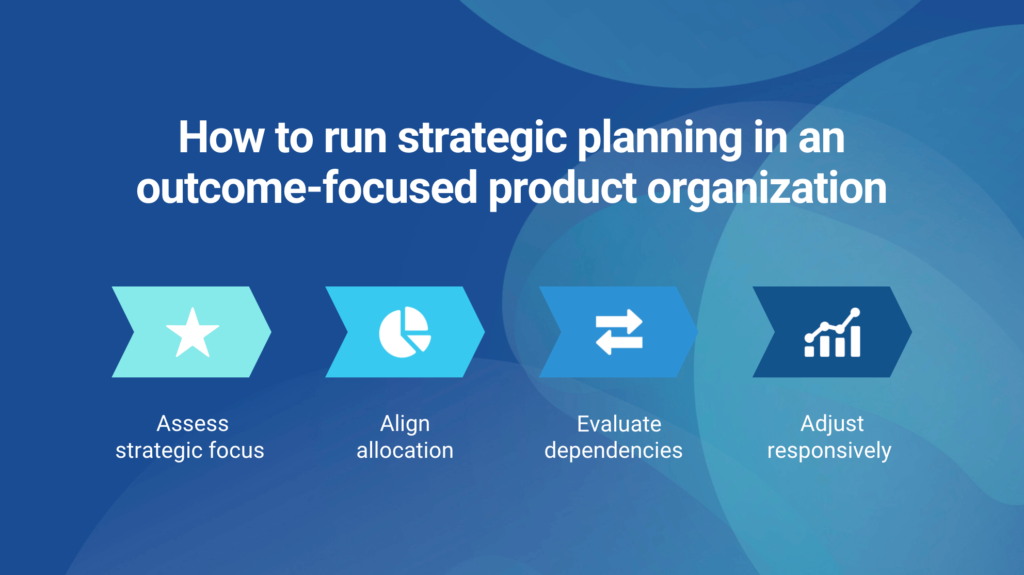
Watch this Strategic Planning for Outcome Focused Teams webinar with Perry Steinberg, Chief Product Officer of AbacusNext to learn how to:
Watch this Leading Product in a Fast-Moving Scaleup webinar with Sridhar Nagarajan, VP of Product, Chatmeter to learn how to:
Top-down alignment refers to the practice where managers and executives set the overall strategy and goals for the organization. When paired with bottom-up innovation, teams are empowered to ideate, build, and deliver the best products possible for the customers and the business.
In Responsive Product Portfolio Management (Responsive PPM), product leaders and their teams take into account three different operating horizons that take place within a product-centric organization. Every organization has long-term, mid-term and near-term focuses and corresponding activities, led by the respective levels of the organization. The operating rhythm such as annual planning, quarterly planning and sprint planning ensue.
Responsive PPM connects the rolling time horizons across all levels to enable strategic alignment and operational autonomy between levels.
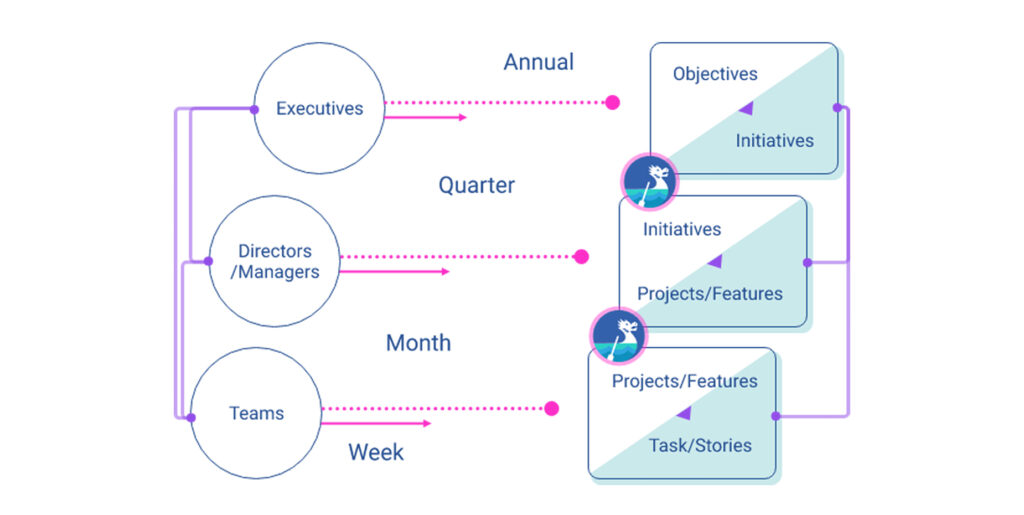
A user story is used in Agile development and is a short, informal, description of what a user wants to do within the software product. Its purpose is to articulate how a software feature will provide value to the customer. User stories typically follow the role-feature-benefit pattern: As a [type of user], I want [an action] so that [a benefit/value].
V2MOM is a goal-setting framework and alignment process that Salesforce founder and CEO, Marc Benioff, claims has been critical to its success. V2MOM is an acronym for Vision, Values, Methods, Obstacles, and Measures.
Benioff created the framework to help employees successfully convince others to align with their vision, prioritize effectively, and scale the process of setting priorities for 100s to 1000s of employees.
Velocity is a metric used to measure the amount of work a team can accomplish during a period of time. Velocity is commonly used in agile development to calculate how much work a team can complete during a sprint. It is typically calculated at the end of the sprint.
The Waterfall methodology is a sequential model for planning, building, and delivering new software products and features in phases of a project. Each phase is completed before the next phase of the project beings. Typical phases include conception, initiation, analysis, design, development, testing, implementation, and maintenance. Over time, Waterfall has taken a backseat to the Agile methodology as the preferred software development environment.
Weighted scoring is a prioritization method that allows you to gauge benefits against costs by assigning metrics to strategic initiatives to score them against each other. Popular product prioritization frameworks that use weighted scoring include MoAR, RICE, MoSCow, and Kano.
Extreme Programming (XP) is an agile software development methodology in which teams aim to produce working software in 1-2 weeks, rather than the usual 2-4 week iteration.
The statistical process of comparing one year of data to the same set of data from the previous year.
Looks like section Z of the product portfolio management dictionary is catching some Zzz’s!
Have a term you’d like to see? Submit it here.
Get started in minutes-no credit card required
